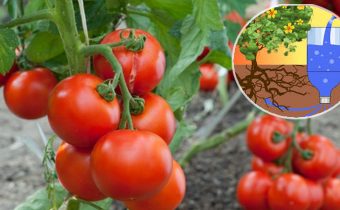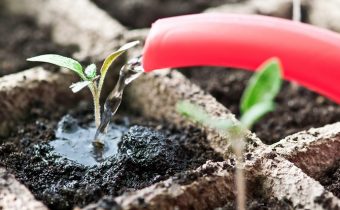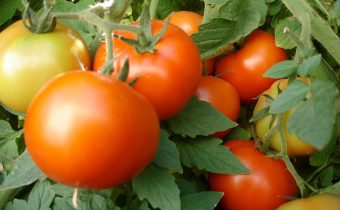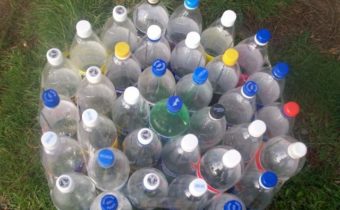Water the tomatoes correctly, tips from experienced gardeners
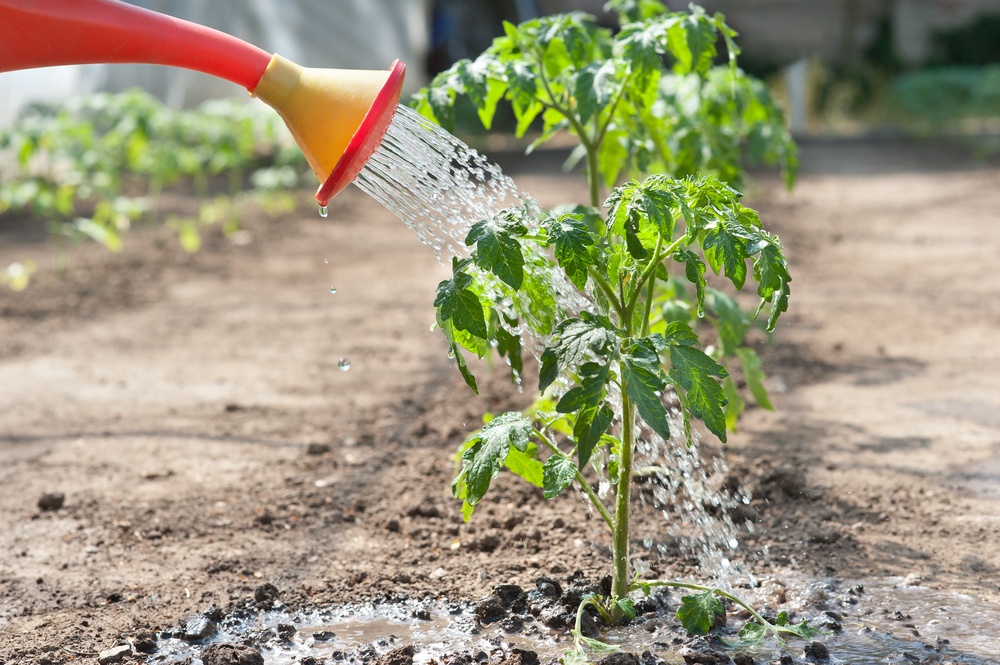
Tomatoes are vegetables that are grown on almost every garden plot. To obtain good yields, it is necessary to carry out the irrigation procedure correctly. However, not everyone knows how to “correctly” water the tomato plants growing on simple beds without shelter in order to collect tasty and high-quality vegetables. This is what the following article will tell about.
- Why is it important to water the tomatoes correctly
- How to water better: watering methods
- The frequency and rate of irrigation of tomatoes
- Peculiarities of irrigation of tomatoes on the type of their growth (determinant and non-determinant)
- Basics of high quality irrigation of tomatoes
- Watering during the heat
Why is it important to water the tomatoes correctly
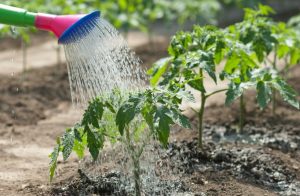 Much depends on timeliness and compliance with the norms of irrigation in different periods of tomato development. So, if the nightshade will experience a lack of moisture, it is fraught with the following consequences:
Much depends on timeliness and compliance with the norms of irrigation in different periods of tomato development. So, if the nightshade will experience a lack of moisture, it is fraught with the following consequences:
- growth and development will be much slower than the established deadlines;
- there may be a massive fall of flowers and lack of ovaries;
- tied tomatoes will grow slowly and gain weight;
- fruit sizes will be much smaller than is typical for the variety.
If there is an excess of moisture in the soil, other problems may arise:
- tomatoes will start to fatten and as a result will cease to bloom;
- there is a high risk of root rot disease;
- increases significantly risk of phytophthora and other fungal and viral ailments;
- the skin of the fruit begins to crack;
- taste is significantly reduced, the taste becomes watery.
How to water better: watering methods
Today, thanks to the achievements of science and the efforts of gardeners, there are many ways and special devices for organizing the irrigation of tomatoes. For tomatoes that grow in the open field, the following are the most suitable:
Watering the beds through the canals (furrows)
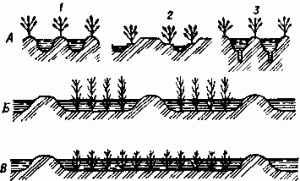 Simple and affordable way for everyone, with a minimum amount of costs. Watering ditches are made along tomato bushes along bushes. It is better if there will be three of them: two at the edges of the garden and one in the aisle. The hose with water fits into one of these grooves (better than the middle one), and the water goes until all three grooves are filled.
Simple and affordable way for everyone, with a minimum amount of costs. Watering ditches are made along tomato bushes along bushes. It is better if there will be three of them: two at the edges of the garden and one in the aisle. The hose with water fits into one of these grooves (better than the middle one), and the water goes until all three grooves are filled.
It is best to prepare the irrigation furrows in advance, even before transplanting seedlings to the garden bed. To do this, they are cut through a distance of 130-140 cm, and the bushes are planted on both sides of these ditches.
Over time, the water will gradually erode the watering grooves, and the tomatoes will actively grow. To preserve the design of irrigation and prevent the roots from being exposed, plants grow up as they grow. As a rule, two or three hilling per season are sufficient.
Drip irrigation
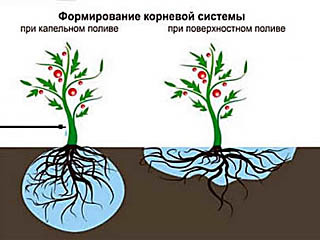 This method is considered one of the best and most reliable, but for its organization it is necessary to tinker. There are two possible options:
This method is considered one of the best and most reliable, but for its organization it is necessary to tinker. There are two possible options:
- purchase a drip irrigation system for factory production;
- build a home-made irrigation system from ordinary plastic bottles.
In the first case, you only need to properly place the drip pipes and adjustable droppers in the garden along tomato bushes. Typically, such systems are equipped with a timer, with which you can program the water supply time.
The second option is much cheaper, but requires some labor costs. It consists in the following.Near each bush at a distance of 15–20 cm from the stem, plastic bottles are dug upside down, to a depth of 10–15 cm. Before this, the following preparatory work is carried out:
- Bottles are prepared in approximately the same amount as tomato bushes grow in the garden. The volume of containers may be different, but two-liter containers are better suited.
- Holes are pierced in the lids of the bottles with a hot nail. For light sandy and sandy soils, two or three holes will suffice; for heavy loamy soil, four or five holes are necessary. In order to subsequently the land did not clog these holes, the cover is wrapped with pieces of nylon (from old nylon tights).
- The bottom of the bottle is cut off completely or left in the form of a cap to avoid debris and for less evaporation of moisture.
When watering the bottles are filled with water. It is very important to ensure that the liquid leaves the soil gradually, and not immediately immediately after watering. If this was noted, the bottle caps need to be changed and the number of holes or their diameter reduced.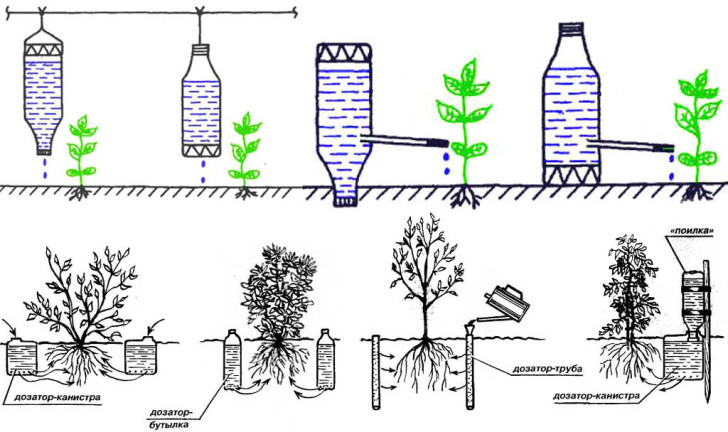
Such a drip-subsurface irrigation has the following advantages:
- water flows directly to the root system of plants and evenly;
- air humidity does not increase, which is of great importance in the prevention fungal plant diseases;
- saving the amount of fluid, time and effort to water.
Tip!
Today on sale there are nozzles on plastic bottles especially for radical watering. They have the shape of a pointed cone, with one end they are screwed onto the necks, the second has a small hole. It is much easier to install bottles with such nozzles than to drop in bottles and for the root system of tomatoes it is safer.
The frequency and rate of irrigation of tomatoes
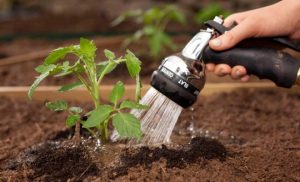 The frequency of irrigation, as well as the consumption rate of water depends on several factors. The first step is to focus on the need of plants for moisture, depending on the phase of development. Equally important are the weather conditions and features of some varieties. Considering all of the above, you can choose the optimal irrigation schedule for vegetable plantings.
The frequency of irrigation, as well as the consumption rate of water depends on several factors. The first step is to focus on the need of plants for moisture, depending on the phase of development. Equally important are the weather conditions and features of some varieties. Considering all of the above, you can choose the optimal irrigation schedule for vegetable plantings.
Watering after transplanting flower beds
There are different opinions of how to irrigate tomatoes immediately after transplanting into the ground. Some agronomists believe that watering during this period should be excluded for 10-12 days. But it is important to plant the bushes in the highly hydrated planting pits, that is, by planting "in the dirt." And over the next two weeks, carry out only the so-called “dry watering”, that is, loosening.
But the overwhelming majority of specialists and experienced gardeners still tend to the fact that in the first days after transplanting tomato plants, on the contrary, an increased amount of moisture is necessary. This will make it easier for them to reschedule the change of living conditions and more likely to settle down in a new place. Therefore, it is recommended to water the plants every day for the first 12-14 days. Consumption rate at the same time 1-2 liters per bush. In the future, watering is reduced to once every five days. The norm in this mode - 10 liters per square meter.
Watering during flowering
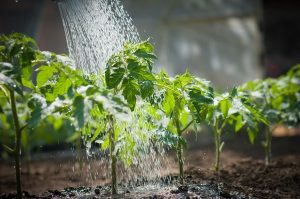 It is very important to properly water the tomatoes during this period. Mistakes made can be quite expensive and take away your harvest. The main rule of watering flowering tomatoes is to water generously, but rarely. The optimum is considered to be watering once every seven days, at a rate of 3 liters per bush. It is important not to allow excessive humidity. This will lead to the fall of color, moreover, moistened pollen can not be sprayed as expected, which means pollination will not occur and the fruit will not be tied up. To avoid increased air humidity, the soil on tomato beds must be covered with a mulch layer, for example, straw. This will prevent rapid evaporation of moisture. When organizing a drip irrigation system problems such as excessive moisture does not happen.
It is very important to properly water the tomatoes during this period. Mistakes made can be quite expensive and take away your harvest. The main rule of watering flowering tomatoes is to water generously, but rarely. The optimum is considered to be watering once every seven days, at a rate of 3 liters per bush. It is important not to allow excessive humidity. This will lead to the fall of color, moreover, moistened pollen can not be sprayed as expected, which means pollination will not occur and the fruit will not be tied up. To avoid increased air humidity, the soil on tomato beds must be covered with a mulch layer, for example, straw. This will prevent rapid evaporation of moisture. When organizing a drip irrigation system problems such as excessive moisture does not happen.
Important!
If it is cloudy and rainy during flowering, tomatoes should be helped to pollinate. To do this, in the morning the bushes or twigs with color gently shake.
Watering during fruiting
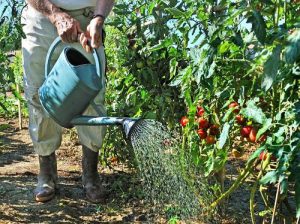 As soon as the green bushes were formed on the bushes, another irrigation rule comes into effect - in no case should the soil be dried out. For this planting irrigate twice a week, while the consumption rate is 4-5 liters per bush.
As soon as the green bushes were formed on the bushes, another irrigation rule comes into effect - in no case should the soil be dried out. For this planting irrigate twice a week, while the consumption rate is 4-5 liters per bush.
If, however, the circumstances were such that watering was not carried out on time and the soil on the beds dried out, the irrigation rate is reduced to one liter per plant. Otherwise, the bushes will greedily begin to absorb moisture, which will lead to the shedding of freshly bound fruits and the cracking of vegetables that have already reached large sizes. The next watering is carried out at the usual norms.
Another sad consequence of improper and excessive watering during fruiting is defeat of tomatoes apical rot.
Peculiarities of irrigation of tomatoes on the type of their growth (determinant and non-determinant)
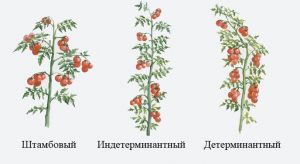 Due to the different length of the growing season, watering of determinant and indeterminate tomatoes is slightly different. So, when growing low-growing varieties in open ground, the rate of irrigation after the formation of ovaries is noticeably reduced, and before harvesting, they stop completely. Due to the fact that the fruits of these tomatoes ripen almost simultaneously, the plant no longer needs an increased amount of moisture. If you continue to water the plantings in the same way as before, this will lead to cracking of the fruits and make them watery. In addition, excessive moisture increases the risk of fungal diseases, such as late blight.
Due to the different length of the growing season, watering of determinant and indeterminate tomatoes is slightly different. So, when growing low-growing varieties in open ground, the rate of irrigation after the formation of ovaries is noticeably reduced, and before harvesting, they stop completely. Due to the fact that the fruits of these tomatoes ripen almost simultaneously, the plant no longer needs an increased amount of moisture. If you continue to water the plantings in the same way as before, this will lead to cracking of the fruits and make them watery. In addition, excessive moisture increases the risk of fungal diseases, such as late blight.
With tall tomatoes the situation is different. The load on indeterminate plants since the beginning of fruiting is very large, since several processes are simultaneously taking place: the growth of vines, flowering, the formation of ovaries and fruit loading. Accordingly, the need for moisture is very large. Therefore, during active fruiting, watering is carried out every four days, and the flow rate is about one bucket of water per bush.
Basics of high quality irrigation of tomatoes
There are general rules for watering tomatoes in the open field. We list the main ones:
- Tomatoes are afraid of watering with hard water, as a result they can develop a disease such as chlorosis. You can soften it as follows: stand for three days or add wood ash (100 grams per 100-liter barrel of water).
- Irrigation is carried out either early in the morning or no earlier than four hours before sunset.
- It is not advisable to loosen, this procedure is recommended to be replaced by mulching.
- At air temperatures below 10 degrees watering is prohibited. Plants are saturated with leaves of moisture from the air.
- Do not allow water droplets to fall on the inflorescences of the plant, its fruits and leaves.
Watering during the heat
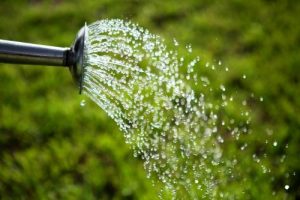 Despite the fact that tomatoes are a southern plant and heat-loving, they tolerate the heat quite hard. In hot weather, watering is preferable to produce in the evening. In this case, during the night period, the plants will have time to be saturated with moisture. As a last resort, tomatoes are irrigated early in the morning, while the sun is not active. If you can not water the vegetable beds in the morning or in the evening it is better not to do this at all.
Despite the fact that tomatoes are a southern plant and heat-loving, they tolerate the heat quite hard. In hot weather, watering is preferable to produce in the evening. In this case, during the night period, the plants will have time to be saturated with moisture. As a last resort, tomatoes are irrigated early in the morning, while the sun is not active. If you can not water the vegetable beds in the morning or in the evening it is better not to do this at all.
At critical temperatures, it happens that after morning watering in the evening the land is again dried out. In this case, conduct additional evening watering. But experts recommend avoiding such situations by mulching the soil in the garden beds.
Regarding the frequency of irrigation, in hot weather it is necessary to carry out the procedure two or three times a week. The consumption rate, depending on the type of tomato and the fruiting phase, is 3-5 liters per bush.
Tip!
Determine whether it is time to carry out irrigation can be on the appearance of plants: foliage wilted or fresh, as well as the flowability of the soil.
Having studied the simple basics of watering tomatoes growing without shelter in the open field, everyone, even the most inexperienced gardener, will be able to grow strong, healthy plants and get a good harvest. For maximum yields, select zoned tomato varieties intended for cultivation in the open field.


